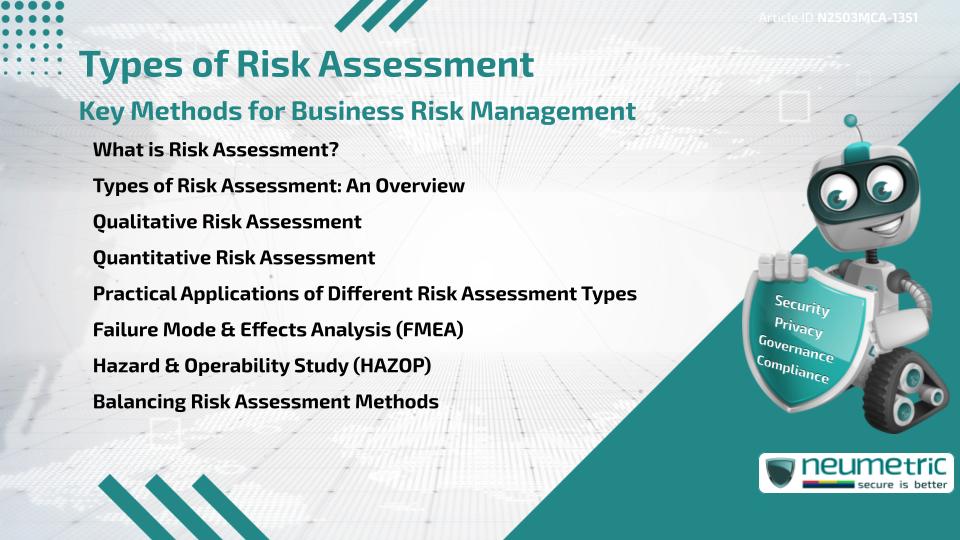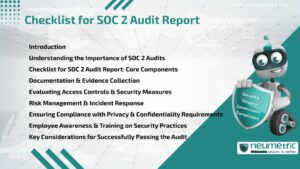Effective Risk Assessment is essential for businesses seeking to safeguard their operations, reputation & resources. Whether you are managing a Startup or a Large Corporation, understanding the Types of Risk Assessment can guide you in Identifying, Evaluating & Mitigating Risks before they escalate. In this article, we will explore different Risk Assessment Methods & their role in Business Risk Management. We will examine their historical development, practical applications & the advantages & limitations of each approach.
Table of Contents
ToggleWhat is Risk Assessment?
Risk Assessment is a systematic process used to Identify, Evaluate & Manage potential Risks that could affect a business’s success. This process involves assessing threats—such as Financial loss, Regulatory Violations, Cyberattacks & Environmental Hazards—and determining how to minimize their impact.
Types of Risk Assessment: An Overview
There are several methods for assessing Risk, each suited to different business needs. Broadly speaking, the Types of Risk Assessment can be classified into Qualitative & Quantitative methods. Both approaches aim to evaluate the severity of risks but do so in distinct ways.
Qualitative Risk Assessment
Qualitative Risk Assessment relies on subjective judgment & experience. It is generally used when precise data is unavailable or when risks are difficult to quantify. This approach often uses scales or matrices to categorize Risks based on likelihood & impact.
Advantages:
- Faster & less resource-intensive: Qualitative assessments are generally quicker & require less data.
- Easier to implement: For businesses without the necessary resources for in-depth Data Collection, Qualitative assessments are an accessible option.
Limitations:
- Subjectivity: Since this method relies heavily on judgment, it may be prone to biases.
- Less accurate: Without Concrete Data, Qualitative Risk Assessments can sometimes overlook critical risks or overestimate minor ones.
Quantitative Risk Assessment
In contrast to Qualitative Risk Assessments, Quantitative methods involve the use of Data & Mathematical models to calculate Risks more precisely. These Assessments measure the probability of Risk events occurring & estimate the Financial impact on the business.
Advantages:
- Objective & data-driven: Quantitative assessments are based on numbers, which can make them more reliable & repeatable.
- Detailed: This method allows businesses to perform a more thorough analysis of Risk exposure.
Limitations:
- Data dependence: Accurate Quantitative assessments require access to a significant amount of Data, which might not always be available.
- Complexity: Developing models to Quantify Risk can be resource-intensive & require specialized expertise.
Practical Applications of Different Risk Assessment Types
Every business faces unique Risks depending on its industry, size & goals. The Types of Risk Assessment chosen will depend on the nature of the Risk & the resources available for mitigation. Here, we will discuss practical applications of various assessment methods.
Failure Mode & Effects Analysis (FMEA)
One of the most common Risk Assessment tools used in industries like Manufacturing & Healthcare is Failure Mode & Effects Analysis (FMEA). This method involves identifying potential failure points in processes or systems, assessing their effects & ranking them based on severity, likelihood & detectability.
Advantages:
- Prevents system failures: FMEA helps businesses anticipate issues & take corrective actions before they occur.
- Applicable in many industries: This method can be used in diverse sectors, such as Automotive, Healthcare & Engineering.
Limitations:
- Resource-intensive: FMEA requires a detailed understanding of the system, which can be time-consuming to gather.
- Subjective ratings: Risk prioritization can still be somewhat subjective despite the method’s structured approach.
Hazard & Operability Study (HAZOP)
HAZOP is primarily used in industries that involve complex processes, such as Oil & Gas, Chemicals & Pharmaceuticals. It aims to identify hazards that could disrupt operations or lead to accidents by analyzing deviations from design intentions.
Advantages:
- Comprehensive: HAZOP looks at multiple aspects of processes, including equipment failures, human errors & operational inefficiencies.
- Industry-specific: Particularly useful for High-Risk sectors with complex operations.
Limitations:
- Highly technical: Requires specialized knowledge & expertise to carry out effectively.
- Not always cost-effective: HAZOP studies can be expensive & time-consuming, especially for smaller organizations.
Balancing Risk Assessment Methods
While each of the Types of Risk Assessment has its strengths & weaknesses, businesses often need to use a combination of these methods to ensure a comprehensive Risk management strategy. For example, a company may combine Qualitative Assessments with Quantitative Models to take advantage of both the speed & precision of these methods.
Combining Qualitative & Quantitative Approaches
A Hybrid approach that blends both Qualitative & Quantitative Assessments can provide a well-rounded perspective on Risk. This Combination enables businesses to account for both the Hard Data available & the Subjective judgment needed to navigate complex, less Quantifiable threats.
Advantages:
- Holistic view: A combined approach captures the nuances of both types of assessments.
- Greater accuracy: By integrating multiple methods, businesses can gain a more accurate understanding of their risks.
Limitations:
- Complex to manage: Combining methods can be difficult for organizations without the right expertise.
- Increased resource requirements: A hybrid approach may demand more time & resources than a single method.
Conclusion
Understanding the Types of Risk Assessment & their respective strengths & limitations is critical for effective business Risk management. Whether you choose Qualitative, Quantitative, or a combination of both, it is essential to select the right method based on your business’s unique needs & available resources. By applying the appropriate Risk Assessment strategies, you can minimize threats & ensure your business stays resilient in the face of uncertainty.
Takeaways
- Qualitative Risk Assessment is faster & easier but less precise.
- Quantitative Risk Assessment offers more accuracy but is data-intensive.
- Combining both methods can provide a more Comprehensive Risk Evaluation.
FAQ
What are the main Types of Risk Assessment?
The main Types of Risk Assessment include Qualitative & Quantitative Assessments, along with specific methods like FMEA & HAZOP.
How do Qualitative & Quantitative assessments differ?
Qualitative assessments are subjective & based on judgment, while Quantitative assessments use data & mathematical models to calculate risks.
What is FMEA & how is it used?
Failure Mode & Effects Analysis (FMEA) is used to identify & rank potential failure points in processes based on their impact & likelihood.
When is HAZOP Risk Assessment most useful?
HAZOP is especially useful in industries with complex processes, such as Oil, Gas & Pharmaceuticals, to identify Operational hazards.
Can a business use both Qualitative & Quantitative assessments?
Yes, a Hybrid approach that combines both Qualitative & Quantitative assessments can provide a more well-rounded understanding of risks.





